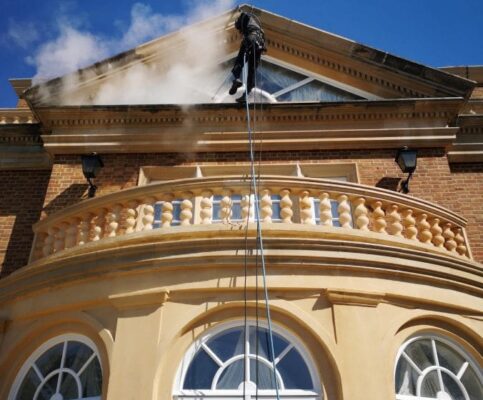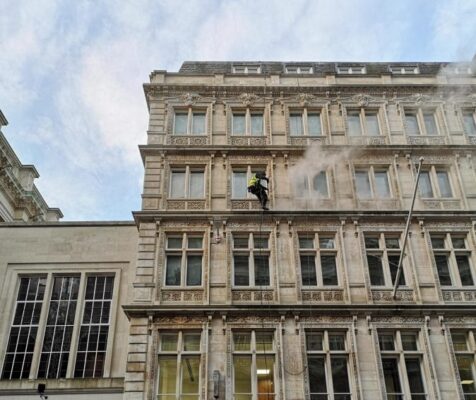View More SErvices Contact Us
Facade Cleaning in Covent Garden
Cleaning building facades from top to bottom, no matter how tall your building.
Natural stone facade cleaning in Covent Garden can be accessed and cleaned efficiently and effectively by using rope access methods. Using this method, the need for local authority permits is totally eradicated, allowing works to proceed immediately. Using professional stone cleaning equipment we can roll back the years to make your building look like new.
Brick cleaning
Brick buildings become dirty as much as any other building. We will not only clean away the dirt and grime, we can revitalise the colour. Using a range of bio-degradable chemicals, we can restore the colour of red or yellow bricks.
Contact UsGlass facade cleaning in Covent Garden
Glass facade cleaning in Covent Garden takes place by abseilers using traditional window cleaning tools. External windows, internal atriums, after builders cleaning or regular maintenance cleans, our abseilers are experienced in all manner of glass cleaning.
Contact UsAluminium cladding cleaning
Aluminium cladding in Covent Garden can become extremely dirty over time. Warehouses that have many lorries coming and going will become soiled with traffic film. Using our steam cleaning systems, this grime is washed away leaving a lasting first impression for your visitors.
Contact UsOur services
Rope Access Facade Cleaning Services for Covent Garden And Surrounding Counties

Residential property Stone Facade Cleaning
Façade cleaning at this residential property in Covent Garden, which was not of any great height but, had no access for other forms of access equipment. Abseiling was the solution and the results were outstanding.

Stone Steam Cleaning in London
This beautiful natural stone building was looking tired from the day to day London traffic. Rope access was seen as the most cost-effective method of access.

Concrete Facade Cleaning in Covent Garden
This car park in Essex was filthy. It hadn’t been cleaned, ever. As the access to three elevations was extremely tight, abseiling was the only method that could achieve the results.

Facade Cleaning in Covent Garden
A new acquisition for our client needed a freshen up. Out of hours abseiling was the best way to clean this building in the heart of the City of London.
Brick colour restoration
Before colour restoration
This client requested a test patch before assigning us the job of cleaning their building. We carried this out with amazing results.
After colour restoration
These are the pictures of the test patch that we sent to the client. Her reaction was simply ‘WOW’. That’s the perfect response for us.
Torik Stone Cleaning System Features
150 degrees centigrade steam cleaning power
Provides a continues flow of superheated water to penetrate stone and deep clean, removing organic growth & ground in dirt.
We use Tensid (uk) Ltd
Providers of specialist cleaning equipment and specialist cleaning chemicals to professionals.
Get In Touch
Fill in the form below and we’ll be in touch within 24hrs of receiving your message.
Facts About Covent Garden
Covent Garden History
During the Roman period, what is now the Strand – running along the southern boundary of the area that was to become Covent Garden. It was part of the route to Silchester, known as “Iter VII” on the Antonine Itinerary. Excavations in 2006 at St Martin-in-the-Fields revealed a late Roman grave, suggesting the site had been sacred since at least 410AD.
hese revealed that a trading town, called Lundenwic, developed around 600 AD. Stretching from Trafalgar Square to Aldwych, with Covent Garden at the centre. Alfred the Great gradually shifted the settlement into the old Roman town of Londinium from around 886 AD onwards, leaving no mark of the old town, and the site returned to fields.
General Info
Covent Garden is a district in London, on the eastern fringes of the West End, between St Martin’s Lane and Drury Lane. It is associated with the former fruit-and-vegetable market in the central square. Now a popular shopping and tourist site, and with the Royal Opera House, itself is known as “Covent Garden”.
By 1654 a small open-air fruit-and-vegetable market had developed on the south side of the fashionable square. Gradually, both the market and the surrounding area fell into disrepute, as taverns, theatres, coffee-houses and brothels opened up. By the 18th century, it had become notorious for its abundance of brothels. An Act of Parliament was drawn up to control the area.



